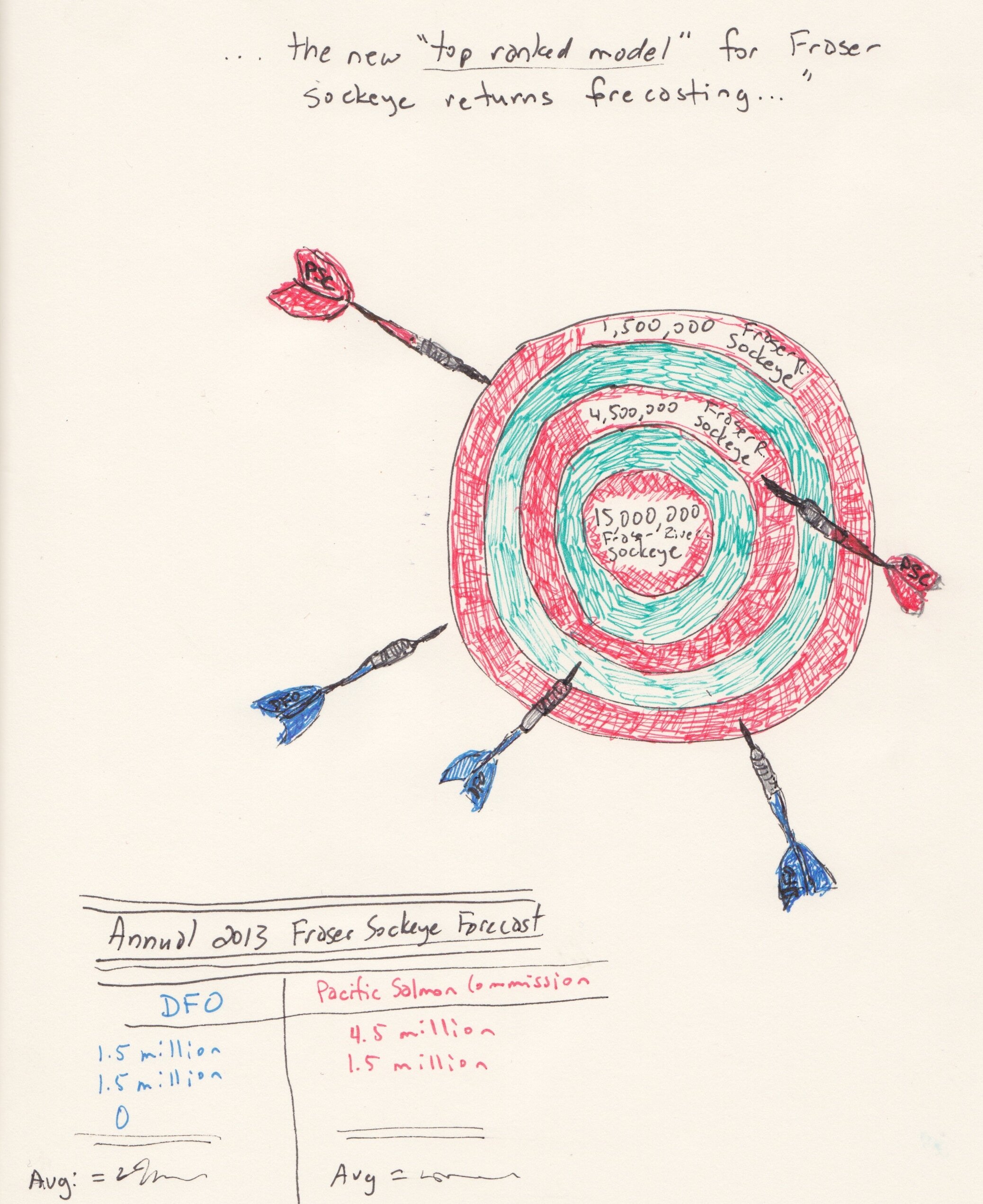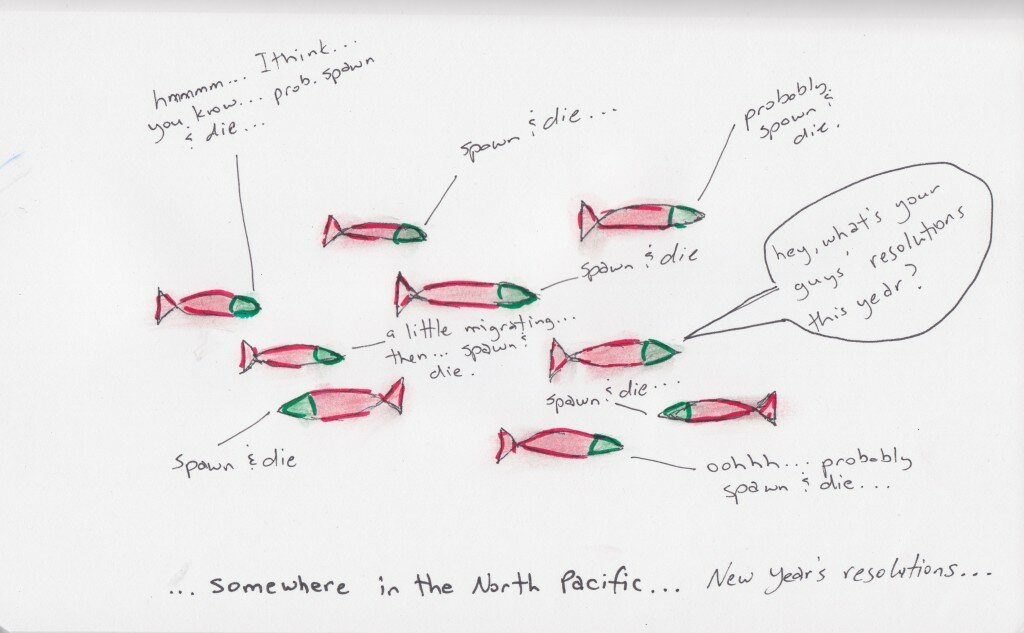
presence – absence ?
Maybe George Orwell said it best some 60+ years or so ago, in his essay: .
A man may take to drink because he feels himself to be a failure, and then fail all the more completely because he drinks. It is rather the same thing that is happening to the English language. It becomes ugly and inaccurate because our thoughts are foolish, but the slovenliness of our language makes it easier for us to have foolish thoughts.
This from : The Uncertain Future of Fraser Sockeye – Causes of the Decline. A discussion by one ‘witness’ in the Commission discussing factors in declines of Fraser sockeye:
“An absence of data, or an absence of evidence to me is not evidence of absence, and I think it’s a little bit dangerous to use an absence of data or an absence of evidence to suggest that contaminants play no role whatsoever or are indeed unlikely to play a role.
…but clearly we’re data deficient in terms of our current capacity to understand what’s happening with the sockeye situation”
So… ummm…. Is it data deficient, or deficient data?
And… does evidence presence mean evidence is in the present… or how about if the President’s evidence is present… Or, absent? Does absence of the President’s evidence mean we have data absence, or data presence, or data presents (like cigars and interns)…?
Is not the absence of data, itself… data? Or is absent data, presence of data absence or just simply absence? What if data absence, become data presence – does that make us wiser? If data absences become data evidences, was not the gap also evidence, or simply evident, or clearly evidents — leading to the gap? If the gap is filled, what becomes of it?
A gap filled, or a filled gap?
Does our “knowledge” really have ‘gaps’…? But aren’t the gaps, still knowledge? Is a gap filled; make better knowledge presence? But still yet, what becomes of the gap?
Is the epitome of all gaps, to become filled, or full-filled… or maybe only half-filled… or is it half-empty? (a half-empty gap, says the pessimistic scientist…)
(I feel for the gap, says the empathetic scientist)…(All i want for x-mas is a tooth-filled gap, says the hockey-playing scientist)
What if a gap filled, in fact, becomes a bigger gap — in knowledge, or evidence, or presence, or absence? What then…
But what of the gap between our reality and our dreams? What becomes of that gap – when filled…?
(Here lies “THE GAP” will say the gravestone… “mighty and gaping in its presence, sad and lonely in its absence.“)
But wait… i can hear the copyright police calling now… …And I will say, I did not know “THE GAP” existed… that is the evidence in my defence… And yet the presence of “THE GAP” in my utterance, is my present offense.
…and they will tell me, as Justice’s well know, ignorance of the law is not a valid defense, and thus stop the pretense.
…and thus the gap in my knowledge will be a detriment, and not a defence… and here evermore absence of presence (e.g. knowledge) becomes a downfall… yet… that absence is still data… data used to prove presence of absence as evidence…
But, what if data abstains in its absence, and in its presence presents evidence?
Does absence of presents present mean conclusively that presents are absent, or simply lacking presence — or is absence of presents due to Santa’s absence? But if Santa is present, reality is absent — isn’t it? (but thankfully, still presents… if you remain a believer)
Yet if reality’s absent, what is mentally present? Mental absence, may mean data presence – but is that data present, and is it a present? In reality’s absence for some, it may become Not criminally responsible which can mean mental absence – says the judge and jury. And, so… to the convicted, evidence of mental absence is the defence of present – some might argue…
Is the data reliable, or simply pliable… like all data that is present or absent. In the present defence, as explained above, presence of absence is the key (e.g. mental). However, with Fraser sockeye salmon, some say it is absence of evidence for ‘smoking guns’. But… for the Province… evidence absence, means the smoke stays in the guns…
If it is absent — data that is — then that does not indicate lack of presence, or presents, or simply pre-sense. Maybe… it seems… it simply means current absence, not abstention. But if data abstains, is it not present? Or is it simply taking a break, or somewhere south, ‘taking the fifth’?
If it’s broken, is it a gap? If there’s a gap does our decision-making wait for presence — or the presents that come with absence of datum?
If there’s a gap, and nobody is looking, is it still a gap? Is it data? Does data only exist when someone is looking? What if they only see in one eye? What if they are near-sighted… is it far-out data? Or far-sighted… is it near-data?
What about data that is right on the 200-mile offshore marker – is it Canadian data, eh? Or is it international data, da? Who owns it? Data is valuable, no? Are gaps, therefore, worthless data, or simply data worth less?
But some gaps are essential and priceless, like the gap that exists between you and oncoming traffic…
And, yet, what is a data gap, and gaping data – but is not data made up of datum… oh wait, it’s more…
Datum, say some, is simply nothing more than “an assumption or premise from which inferences may be drawn.”
Ohhhh… so presence of inference, does not imply absence of assumption – it actually means presence of premise, and presence of assumption. But assume does not indicate a present to the law, nor to the convicted… assume is a danger because as the old ditty goes: it makes an “ass” out of “u” and “me”…
And so we Houston, BC may very well might have, very likely presence of a problem or absence of a solution…likely, or may have…highly probable, but debatable…
Further, according to Dr. Ross, contaminants very likely contributed to the long-term decline in the sense that they may have contributed through small incidents here and there (i.e., “death by a thousand cuts”) or they may have weakened the fish over time, such that when they went to sea they may have been more vulnerable.

death of a thousand cuts – Cartoon drawn at the beginning of the Cohen Commission in 2010…
And there, in that last fragment we have the great ecosystem killers of “very likely” and “they may have“3
Now pardon the cynic in me, but wasn’t the “Terms of Reference” for Justice Cohen and the Commission:
C. to investigate and make independent findings of fact regarding:
I. the causes for the decline of Fraser River sockeye salmon…
Last time I checked, “may have” and “most likely” were in the ‘absence of evidence’ or simply ‘evidence absence’ category within the legal realm, let alone the factual realm.
Orwell concludes well:
If you simplify your English, you are freed from the worst follies of orthodoxy… Political language… is designed to make lies sound truthful and murder respectable, and to give an appearance of solidity to pure wind…
Do we honestly think that we can gain ALL of the evidence from this realm?:

Map from Cohen report: Fill ALL the data gaps?
Here is Justice Cohen’s language in the ‘decline of Fraser sockeye’ from Volume 2:
Life stage 1 findings
I find that there are plausible mechanisms during the incubation, emergence, and freshwater-rearing parts of life history stage 1 by which numerous freshwater stressors, such as effluent, contaminants, predators, warming streams and lakes, infectious diseases, agriculture, and surface and groundwater extraction may have contributed to the decline.
Although these mechanisms are understood, there is insufficient evidence about the actual impacts these stressors, either singly or cumulatively, have on Fraser River sockeye during this life history stage.
These mechanisms are understood, but “actual impacts” is not? And “may have” contributed…
Hmmmm…
Are we wanting these issues of great, grand ecosystems to look like the ‘mechanisms’ of a bank account…?
As in, “well, mr. salmonguy you say that you ‘may have‘ deposited money to your account, however, we can clearly see that you did not…”
Ecosystems like the North Pacific, or even the Fraser River watershed are mightily complex, complicated, and largely unpredictable entities.

Fraser River watershed
Are we humans expecting that we will delay doing something about certain issues until the evidence is present? Or that ‘findings of fact’ are what is required for action to be taken so as to limit our impacts on other things?
The decline of Fraser sockeye is not due to some unknown entity… We, humans have delivered a good solid 95% + of the “thousand cuts”…
Us. You and Me and Dupree and the other 6 billion+ living souls.
And yet, even if the apparent mechanisms and “actual impacts” slept in the same bed of meaning and ‘understanding’… what would we really do about it?
Wait for the scientists to agree…?
First we’d have to wait for scientists to agree on which knife was delivering the cuts… or wait, was it an axe… no, it was a machete… no, it was a handsaw…
And the salmon farming industry scientist would probably say “what cuts?”
Then we’d have to wait for the proposed ‘solution’… but no, first we’d do that as a ‘pilot study’… then a new government would come into power and cut the funding, and implement ‘their solution’… then some scientists would need to use whistleblower protection and hire security guards, then the Auditor General would get involved, then there’d be a snap election, then there’d be a call for a judicial inquiry… then a court case or two, an appeal, a new government, a fiscal cliff, austerity measures, a bull market, a bear market, a new government… a new scientific discovery… then space travel would take funding priority, then government “Action Plans”, then another review of spending, another court case… and so on and so on.
… go back to top, read again, and rinse and repeat if necessary… (that is if you believe that little ditty on shampoo bottles… ‘rinse and repeat’…).
And if you do then the productivity of Proctor and Gamble will increase a heck of a lot faster then any Pacific sockeye population…
I see evidence of absence that anything is going to change anytime soon… just simply start by doing a rough calculation on the ‘cost’ of Justice Cohen’s recommendations, and this is just for FRASER SCOKEYE – not the other Fraser salmon populations, like the endangered Fraser coho or Chinook… and let alone the other five species of salmon spread throughout BC.
Like every other collapsing fish population with a ‘commercial value’… we will argue, bicker, and use useless language until the last viable population swims into the annals of “was”…













